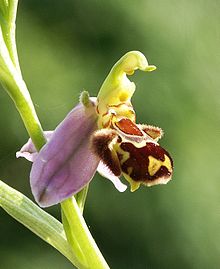Ophrys apifera
Ophrys apifera Huds. is a terrestrial, monopodial orchid of the subtribe Orchidinae (family Orchidaceae). It is called the bee orchid. There are two species of so-called bee orchids: one, Ophrys apifera, has perhaps the widest distribution of the Ophrys species. The other, Ophrys schulzei, is an oriental species that occurs only in Anatolia and the Middle East.
Habitat
This terrestrial, monopodial species is distributed from the Mediterranean to the Caucasus. In humid lands and in grasslands where it stands out due to its great height of almost 50 cm.
Description
Ophrys apifera has a small, globular, underground tubercle that serves as a food reserve. From this tubercle comes the simple erect floral stem without ramifications. During the summer this orchid is dormant. At the end of the summer-autumn it develops a rosette of leaves. A new tuber also begins to develop, which matures the following spring. In the following spring the floral stem begins to develop, and during flowering the leaves already begin to wither.
The plant is usually 30 cm tall. The leaves are oblong-lanceolate, rounded, without indentations, bluish-green. They form a rosette. They develop in autumn and can survive winter frosts.
The flowers have a large labellum. The lip is dark brown with lighter brown spots, white lines, and pale yellow. The lip has three lobes with the lateral ones turned forward with fine silky hairs. The larger lobe is rounded and turgid with a base of whitish hairs, often with purple spots forming an X or an H. The sepals are of the same size and consistency, about 7 mm long and a homogeneous pink colour.
Two to ten flowers develop on the flowering stem with basal leaves. The flowers are unique not only for their unusual beauty, color gradation and exceptional shapes, but also for the ingenuity with which they attract insects. In this case, its labellum imitates the abdomen of a female bee, a plant specialized in attracting male bees to pollinate the flower. They are usually pollinated by bees of the genus Eucera in the Mediterranean region, but in more boreal regions they are sometimes self-pollinated.
Taxonomy
Ophrys apifera was described by William Hudson and published in Flora Anglica 340. 1761.
- Etymology
See: Ophrys, Etymology
From the Latin "apifera"="bearing bees" referring to its lip, which takes the shape of a bee for pollination.
Ophrys is first mentioned in the book "Natural History" by Pliny the Elder (23-79 AD).
- Natural hybrids Ophrys apifera
- Ophrys × albertiana (Ophrys apifera × Ophrys holoserica(Europe)
- Ophrys × albertiana nothosubsp. morellensis (Ophrys apifera × Ophrys holoserica ssp. candica(Italy)
- Ophrys × circaea (Ophrys apifera × Ophrys bombyliflora(Italy)
- Ophrys × domus-maria (Ophrys apifera × Ophrys exaltata ssp. arachnitiformis(France)
- Ophrys × flahaultii (Ophrys apifera × Ophrys sphegodes(France)
- Ophrys × insidious (Ophrys apifera × Ophrys aegirtica(France)
- Ophrys × luizetii (Ophrys apifera × Ophrys araneola(France)
- Ophrys × minuticauda (Ophrys apifera × Ophrys scolopax(France, Sardinia)
- Ophrys × minuticauda nothosubsp. donorensis (Ophrys apifera × Ophrys scolopax ssp. conradiae(Cerdeña)
- Ophrys × minuticauda nothosubsp. minuticauda (France)
- Ophrys × pietzschii (Ophrys apifera × Ophrys insectifera(Europe)
- Ophrys × soller (Ophrys apifera × Ophrys vernixia ssp. ciliata(Baleaders)
- Ophrys × vespertilio (Ophrys apifera × Ophrys bertolonii(Italy)
- Sinonimia
- Arachnites apifera (Huds.) Hoffm. 1804
- Arachnites apifera Tod. 1791
- Ophrys albiflora Spruner ex Boiss. 1882
- Ophrys apifera f. flavescens (Rosbach) P.D.Sell in P.D. Sell & Murrell 1996
- Ophrys apifera f. trollii (Hegetschw.) P.D.Sell in P.D.Sell & Murrell 1996
- Ophrys apifera subsp. Austrian (Wiesb. ex Dichtl) K.Richt. 1890
- Ophrys apifera subsp. chlorantha (Hegetschw.) Arcang. 1882
- Ophrys apifera subsp. trollii (Hegetschw.)
- Ophrys apifera var. almaracensis Perez-Chisc. 1990 publ. 1991
- Ophrys apifera var. aurita (Moggr.) Gremli 1887
- Ophrys apifera var. basiliensis S.Schwegler " Matthies 2004
- Ophrys apifera var. Belgianrum Turner Ettl. 1998
- Ophrys apifera var. chlorantha (Hegetschw.) K.Richt. 1890
- Ophrys apifera var. flavescens Rosbach 1880
- Ophrys apifera var. fulvofusca M.P.Grasso " Scrugli 1987
- Ophrys apifera var. immaculata Bréb. 1849
- Ophrys apifera var. muteliae Mutel 1835
- Ophrys apifera var. tilaventina Nonis & Liverani 1997
- Ophrys apifera var. trollii (Hegetschw.) Rchb.f. 1851
- Ophrys aquísgranensis Kaltenb. 1850
- Ophrys arachnites Mill. 1768
- Austrian ophrys Wiesb. ex Dichtl 1883
- Ophrys chlorantha Hegetschw. 1840
- Ophrys epeirophora Peter 1883
- Ophrys immaculata (Bréb.) O.Nägeli 1916
- Ophrys insectifera L. in part 1753
- Ophrys insectifera subvar. aurita Moggr. 1869
- Ophrys penisdensis Kalkhoff 1914
- Ophrys purpurea Tausch 1831
- Ophrys ripaensis Porta 1905
- Ophrys rostrata Here. 1830
- Ophrys trollii Hegetschw. 1840
- Orchis apifera (Huds.) Salisb. 1796;
Common name
Bee, Parnassus bees, abejera, little bee, dog companion, bee flower (2), bee flower, bee grass.






